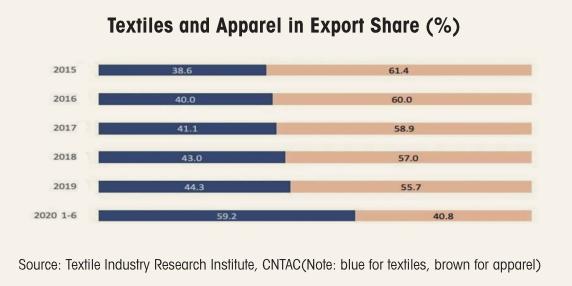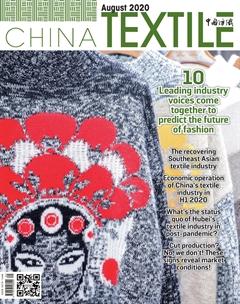The first time in the first half,China hit a positive growth
By Zhao Hong
China turned out to hit the first-time positive growth in its textiles and apparel export since the new year started, amounting to $125.19 billion, up by 3.2% over the comparable period last year, 5.6 percentage points higher than the previous timeframe, meaning the first six months last year witnessed a negative growth without the coronavirus impact.
The achievement is remarkable if we see that the whole macroeconomic performance has not yet fully recovered despite the overall economic reopening as is in the case of the total export that registered $1.09875 trillion, a decline by 6.2% from January to June when the textile industry stood out to take the lead in reversing the downtrend.
Amid the optimistic mood and growth momentum, there is a growing worry over the product structure in export portfolio that shows a decrease of the finished goods, saying, the apparel, while the primary products, the textiles so to speak, elbow their way to take more share in total textile and apparel shipment.
The most updated statistics during 1 - 6 months, 2020, speak well for this trend that shows apparel export declined by 19.4% to arrive at $51.08 billion, representing 40.8% in total share. Once the bulk of the total export is now reduced to a minor on the grounds that the apparel export has been descent over the years, and the first five months this has also seen a fall across the board in the major markets, respectively in the United States by 34.49%, in EU by 17.06%, in Japan by 9.28% and in the countries along the"Belt and Road" Initiative areas by 20.27%.
Of course, the apparel export ramp-down is coincidental with the sharp drop in clothing retails in those important markets with the United States by 47.8% and EU by 77.8% and Japan by 27.1% from January to May as is indicated in the data source available.
Speaking of the textiles export, much of its rapid growth is credible to medical and health textiles and fiber-based protective gear at the time when the pandemic runs loose and the demand for the protective wear runs tight on global basis. As we get to know from the government white-paper report ”China Action in Combating COVID-19“, China already shipped out 70.6 billion pieces of face masks to 200 countries and regions in the world from March 1st to the 31st of May even though a population of 1.4 billion people are urgently in need of these protective mouth wears for the pandemic prevention and control in China.
In view of the important destinations, EU, the United States and Japan obviously rely on imports from China to ease their own shortage of supply. According to Eurostat, the 27 countries in the bloc imported 4.76 billion euros worth of face masks from China in the first four months, 11.8 times as much as that in the same period last year, and the data sources from U.S. Customs and Trade Statistics of Ministry of Finance, Japan, show that the imports of these products from China for 5.59 billion U.S. dollars and 267.84 billion Japanese Yens, a growth by 4.7 times for the former and 1.6 times for the latter, accounting for 89.2% and 93.9% in their import share, respectively in the first 5 months taken together.
Would this trend of growth momentum be able to sustain as the pandemic die away some day? The export decline for garment poses a challenging issue when the employment is taken into a serious consideration of the fact that the production process for the upstream products, like manmade fibers, yarns, fabrics, dyeing and printing lines, is highly automated with as few operators as possible, and this labor-intensive manufacturing sector must maintain competitive while providing more jobs, and where is the way out?
- China Textile的其它文章
- Dear readers
- 10 Leading industry voices come together to predict the future of fashion
- The recovering Southeast Asian textile industry
- 97 percent Bangladeshi products to get duty-free access to China,and India to lose its competitive advantage
- Vietnam market demand will resume,but the whole year exports may fall
- How about the textile and apparel industry in Cambodia,Myanmar,Laos and Thailand in the first half of the year?

